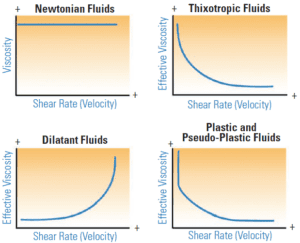What is Viscosity?
Our last blog post we looked at a case study where we were seeing a lot of slip in a Waukesha Universal 2 pump. While there are many factors that can impact a process, fluid viscosity will be one of the most important factors that decide ho w we size the proper equipment for your application. Today, we will share a brief overview of viscosity and why most applications are dominated by the effects of viscosity.
w we size the proper equipment for your application. Today, we will share a brief overview of viscosity and why most applications are dominated by the effects of viscosity.
Viscosity is the measure of the internal friction of a fluid. In other words, viscosity is a fluid’s resistance to flow. Imagine a thin layer of fluid is made to move parallel in relation to another layer. The greater the friction within the fluid means the greater the amount of force required to maintain this movement. This type of force is known as shear and it is this shearing action that occurs whenever a fluid flows whether it be pouring, spraying, mixing, etc. Viscosity can help us to explain why we can more easily move through air, which has a very low viscosity, than we can move through water, which has a 50 times higher viscosity.
Newtonian vs Non-Newtonian Fluids
When Isaac Newton performed his studies on fluids, he assumed that all materials have, at a given temperature, a viscosity that is independent of the shear rate. In other words, twice the force would move the fluid twice as fast. Fluids that exhibit this type of behavior are Newtonian fluids. It turns out that Newton was only partially right—a much more complex group of fluids exists and, unfortunately, are much more common.
Thixotropic fluids –A thixotropic fluid undergoes a decrease in viscosity with time while subject to a constant shearing. Some examples include yogurt, peanut butter, soaps, vegetable oils, and some slurries.
Dilatant fluids— Viscosity increases as shear rate increases (shear thickening). Some liquids with dilatant behavior are slurries, candy compounds, and cornstarch & water mixtures.
Pseudoplastic fluids—Viscosity decreases as shear rate increases (shear thinning). Examples ketchup, molasses, syrups, blood, and some silicone oils and coatings.
As you can imagine, there are dramatic differences in fluid viscosities within the food industry. The chocolate industry presents one manufacturability challenge where the desired texture and flow of chocolate can be difficult to maintain. Not only does the production process of molten chocolate depend on a well-defined viscosity, but properties of the finished product such as the texture and taste are directly related to its viscous behavior as well. Chocolate manufacturers must carefully consider the viscosity of their product in order to achieve their desired density, texture, and taste.
In the biotech industry, investments in new drugs and devices are enormous and viscosity is a key indicator of quality in a wide range of biotech applications from pharmaceuticals to mechanical devices to medical laboratories. For example in pharmaceuticals, we would want our cough syrup to smoothly flow past the digestive tract for proper delivery. Or we would want an ointment to stay in the affected area and not flow off. Therefore it is important that the desired value of a viscosity is achieved for every pharmaceutical product.
At Holland, we offer a wide range of products and solutions for your sanitary applications regardless of viscosity. Whether you need help selecting the right peristaltic pump tubing or you need help sizing a mixer, contact a Holland Sales Engineer today for your application needs.







